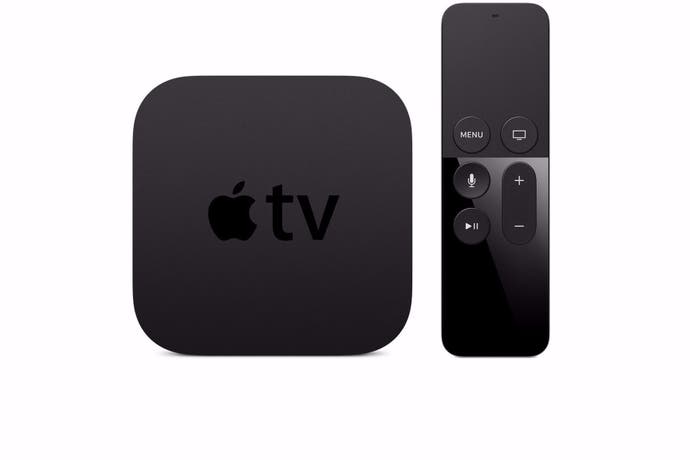Apple TV 2015 review
Cupertino's next-gen media streamer falls short as a games machine.
According to Apple, the future of TV is apps - where streaming media content combines with a modicum of processing power in order to bring us the entertainment we want, when we want it, backed up by a range of functionality and discoverability that traditional TV simply can't supply. The fact that more powerful hardware is at the core of all of the next-gen streamers means that they also double-up as games consoles too, turning the likes of the new Apple TV and Nvidia Shield Android TV into all-in-one entertainment centres. But what more do they offer compared to standard consoles or cheapo media boxes - do we really need a set-top box revolution?
This was the question we pondered when we first heard about the release of the 2015 Apple TV, but the more we thought about this device, the more concerns we had, especially in terms of its gaming credentials. The new Apple TV is based on mobile titles - great for your smartphone but do they actually scale up well on big-screen flat panels? Further question marks surrounded the viability of Apple's remote as a viable gaming interface too.
We've been road-testing both Apple TV and Shield Android TV for a while now and have come to a simple conclusion: as media streamers, these devices' faster processors and superior UI design make accessing content a lot easier than an entry-level box and there are some really cute features, but the bottom line is simple - you're still accessing the same content at the same quality level as you were before. And that's if it's available at all - right now both Apple TV and Android TV lack comprehensive media support.
As things stand, Apple's approach to redefining the media experience is two-pronged in nature. First of all, there's the introduction of Siri as a voice control mechanism for accessing and discovering content. The idea is that you can simply ask to watch the shows or movies you're interested in, whether you address them directly by name, or via actors or directors you may follow. You can even be highly general in your searches - for example, 'show me the best action movies of 2010' produces exactly the results you might expect. And from there, a big, big bunch of related content is easily accessible.
In theory, this is the killer app, but it's very similar to Android TV's voice control interface in terms of both its strengths and weaknesses. As a discoverability tool it can be highly effective, but the main problem is that voice control support is not mandatory on all apps. So Apple TV may well be able to show you the best action movies of 2010 on command, but when you ask for something more basic like, "I'd like to watch last night's Doctor Who", you're going to be disappointed because the BBC iPlayer catch-up app has no voice support whatsoever. Instead - at best - you're funnelled through to episodes of Doctor Who that Apple wants to sell you. At worst, you end up with a single result - Dr Brian Cox's lecture on the science of Doctor Who. Siri seems intent on punting content your way even if it has only the most tenuous link to what you actually asked for.
It's a very similar problem we had with voice control on Android TV. The voice UI should be the glue that holds all of the apps together, providing the unifying experience that makes a premium media streamer worthwhile. Instead, spotty app support means that it becomes a gimmick you soon grow tired of after one failed search result too many. Apple TV does have one advantage over Android TV in this regard though: voice control is supported on Netflix. If your content library is based on solely on services that do support voice, maybe this supposed revolution in control will work for you.
Apple's second innovation in the media streamer space comes from the brand new remote - a premium quality device armed with motion control support plus a sensitive touchpad allowing you to thumb your way around the responsive UI (scanning through movies in particular works brilliantly). The remote feels good in the hand and the level of response from the touchpad is just right. The one weakness is the cheap-feeling clicky touchpad button - a surprise misstep bearing in mind Apple's brilliance here in its other products - the innovative ForceTouch technology on its laptop trackpads is simply sublime, for example. The remote is charged with a standard Lightning cable included in the box, but what's missing is any kind of actual charger. Apple seems to assume you already have one, but if you don't, you're expected to charge from your computer (!).
Generally, the new icons-based UI and the remote pair up very well, but there is one highly frustrating weakness - text input. Entering usernames and passwords is a torturous experience. Setting up iTunes access can be made much easier by pairing up an existing iOS device, but that does rather assume you actually have one. Outside of iTunes, there's no escaping a ponderous, sub-optimal experience that is actually made worse by the analogue nature of the touchpad.
And unfortunately, the gaming credentials of the Apple TV are also compromised by the design of the remote. We went into the experience thinking that we'd be looking at an evolution of the Wii remote - some kind of attempt to graft nunchuk and wand into a single entity, but the end result is too compromised to be truly effective. Galaxy on Fire: Manticore Rising gives the gyroscope a SixAxis-style workout, proving to be just as imprecise as the short-lived PS3 experience, while Harmonix' Beat Sports - a disappointing release bearing in mind the developer - shows little evidence of the same level of precision evident in Nintendo's controller.
That said, Asphalt 8 fares better - it sees players hold the controller on its side, using motion control to steer. The lack of feedback is obviously a problem, but it is the most effective use of motion control we found during gaming. Braking is achieved using the touchpad's clicky button, and the pause button can be used for nitrous, indicating that developers at least have access to two physical buttons.
Unfortunately, while the remote's touchpad may work fine for the UI, it's clearly sub-optimal for gaming. The device itself is very small, meaning that there's not much 'travel' for directional control on the touchpad and again, granular control feels almost impossible - navigating gates in Geometry Wars 3 is nightmarish, for example. Even basic swipes have issues - moving about in Crossy Road requires you to hold the remote straight at all times so that swipes upward are not registered as left or right movement. Of course, you can buy a 'proper' gaming controller to accompany Apple TV, but it's extra cash on top of what is already a premium-priced device.
It's difficult not to feel that the Apple TV is compromised in almost all areas. The remote doesn't feel right as a gaming device and lacks Apple's cutting-edge interface tech - functionality that could empower game creators rather than holding them back. Meanwhile, the A8 processor is last year's technology - capable enough (though Beat Sports' sub-par frame-rates may beg to differ) but offering nothing like the raw power of the Shield Android TV, or indeed Apple's own iPhone 6S. Using last year's tech has a knock-on effect on media playback capabilities too: there's no 4K support and - as far as we know - no HEVC/h.265 decoding, meaning that next-gen streaming isn't an option here. Both Shield Android TV and the latest Fire TV have these features and of course, Netflix is already supporting 4K streaming.
Apple TV 2015 - the Digital Foundry verdict
Ultimately, the Apple TV succeeds in improving the speed and efficiency of the media user interface thanks to its faster, smoother smarter UI, the effectiveness of which is boosted still further with an improved remote. As a client for an iTunes library, it's very good, while the voice-controlled Netflix support is also a welcome bonus. But the lack of cohesion in the rather basic interface and the omission of mandatory voice support for all media apps makes Siri feel like a short-lived gimmick. We'd also urge you to check that the media you want to watch is actually supported by the Apple TV - the BBC iPlayer app only came online recently, for example, while Amazon Prime still isn't supported. UK users looking for the complete suite of catch-up TV apps will also come away disappointed. In this respect, for UK buyers, the bargain basement Now TV box actually offers a more comprehensive range of catch-up TV app support.
It's difficult to avoid the conclusion that Apple TV didn't launch as a fully rounded media streamer, lacking the kind of unified standards that could have truly revolutionised how we watch TV. And beyond that, if the future of the TV is apps, radical new ideas are required. As things stand, the idea of transplanting apps away from your mobile device to the TV screen feels like another idea that doesn't quite work. Take the AirBnB offering for example - it's great to look at full-screen photography of the properties you're interested in but in terms of core functionality (actually booking somewhere to stay, for example), the existing mobile app or desktop site gets the job done while the TV app doesn't. There may be apps where a larger screen trumps the extra level of functionality you'll get by using your phone, laptop or tablet, but there's the sense that Apple doesn't quite understand just why apps work best on mobile devices. What's the point of an interactive cookbook app for the TV when I can actually take my phone into the kitchen with me?
Finally, as a games machine, Apple TV fares poorly. It's a compromised product in terms of its core technology - and its control set-up is really going to challenge developers. The move from physical controls to touch-screen was difficult enough, but the new remote is effectively an even more constricted form of the same interface. We were looking for a breakthrough here, a genuine Eureka solution here on par with the mainstream appeal of the Wii remote, but the Apple TV doesn't deliver.
In conclusion, it's difficult not to feel a sense of disappointment with the arrival of Apple's first games console in the modern era. There are the foundations of something impressive here - but in media terms, it needs consistency, continuity and coherence across all apps if the grand concept behind the Apple TV is to become more than a gimmick. And in a world where Netflix streams in 4K with perfectly serviceable ultra HD displays now selling under £400, launching a premium media streamer using already out-dated technology is a serious misstep. It's often said that Apple products come into their own in their second-gen iterations, and that may well be the case here. But the notion that such an important launch could fall short in so many areas is both surprising and disappointing.









